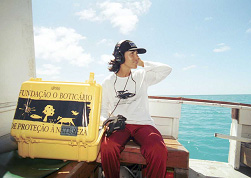
Renata S. Sousa-Lima - rsl32@cornell.edu
Cornell University, Bolsista do Governo Brasileiro (CAPES)/Instituto Baleia
Jubarte
Maria E. Morete - Instituto Baleia Jubarte / Universidade de Sao Paulo
Roberto C. Fortes - Instituto Baleia Jubarte
Ana C. Freitas - Instituto Baleia Jubarte
Marcia H. Engel - Instituto Baleia Jubarte
Popular version of paper 5pAB2
Presented Friday afternoon, December 6, 2002
First Pan-American/Iberian Meeting on Acoustics, Cancun, Mexico
Every year the Abrolhos archipelago, situated in Northeastern Brazil, is the stage of a great show in the breeding season of humpback whales. These breathtaking creatures migrate from cold high latitudes to tropical waters where they breed, give birth, and nurse their calves. The Abrolhos Bank is the most important breeding ground for humpbacks in the Western South Atlantic. Approximately 2,000 whales visit the area from June to November. This abundant megafauna has directly contributed to a prodigious growth in whale watching activities over the past several years. What is the impact of this activity on the reproductive behavior of these whales? Does it disturb their breeding? One of the primary behaviors observed in humpback whale breeding areas is the strange and beautiful vocal performance of singing males. The characteristics of humpback whale songs were described for the first time in a 1971 Science article by Payne and McVay. The authors determined that the song is composed of a series of notes which form phrases. These phrases are repeated in themes that follow a particular sequence in the full song, which lasts approximately 15 minutes. Astonishingly enough, an individual male can sing for several hours without stopping, repeating his song many times over. In 2000, with financial support provided by the Fundacao O Boticario de Protecao a Natureza, MacArthur Foundation and Society for Marine Mammalogy, our research team has conducted a series of experiments to determine the impact of motorboat approaches on the singing behavior of male humpback whales in the Abrolhos region.
Specifically, we looked for alterations in various song characteristics in relation to the activity of an approaching boat. After localizing a singer, part of the research team boards a small zodiac boat and approaches the whale silently using an improvised sail. First, the song is recorded using a hydrophone (a special underwater microphone) connected to a digital audio recorder. After recording at least one full song without any disturbance from a motorboat, we signal the research vessel to initiate an approach, while continuing to record the song. The position of the boat in relation to the whale, various types of behavioral data, and information concerning the speed of the motor are collected before and after the boat approach by both the researchers aboard the research vessel and a land-based team (situated at the highest point of Santa Barbara Island). The sound recordings, correspondent distances, and behavioral data are then analyzed to detect differences in song performance before, during, and after the motorboat approach. In the two individuals that we have analyzed thus far, significant differences in song performance were detected. In essence, males sang shorter versions of their songs when exposed to boat noise. The duration of the phrases in the song remained the same but the number of phrases in each theme decreased. In three different cases we observed that males stopped singing right after a motorboat switched gears within 300 meters and resumed singing when the engine was returned to neutral. It is still unknown whether or not the interruption or alteration of song performance may ultimately jeopardize the reproductive success of a disturbed male. Given the limited number of observations, further investigation is still necessary to provide scientists and officials with the knowledge required to establish better rules and regulations regarding tolerable levels of disturbance, while still permitting economically important whale watching activity to continue.
If you are interested in learning more about the Brazilian Humpback Whale Institute (http://www.cria-ativa.com.br/jubarte/) and the Bioacoustics Research Program at the Cornell Lab of Ornithology (http://birds.cornell.edu/BRP/), please visit our web pages.el


